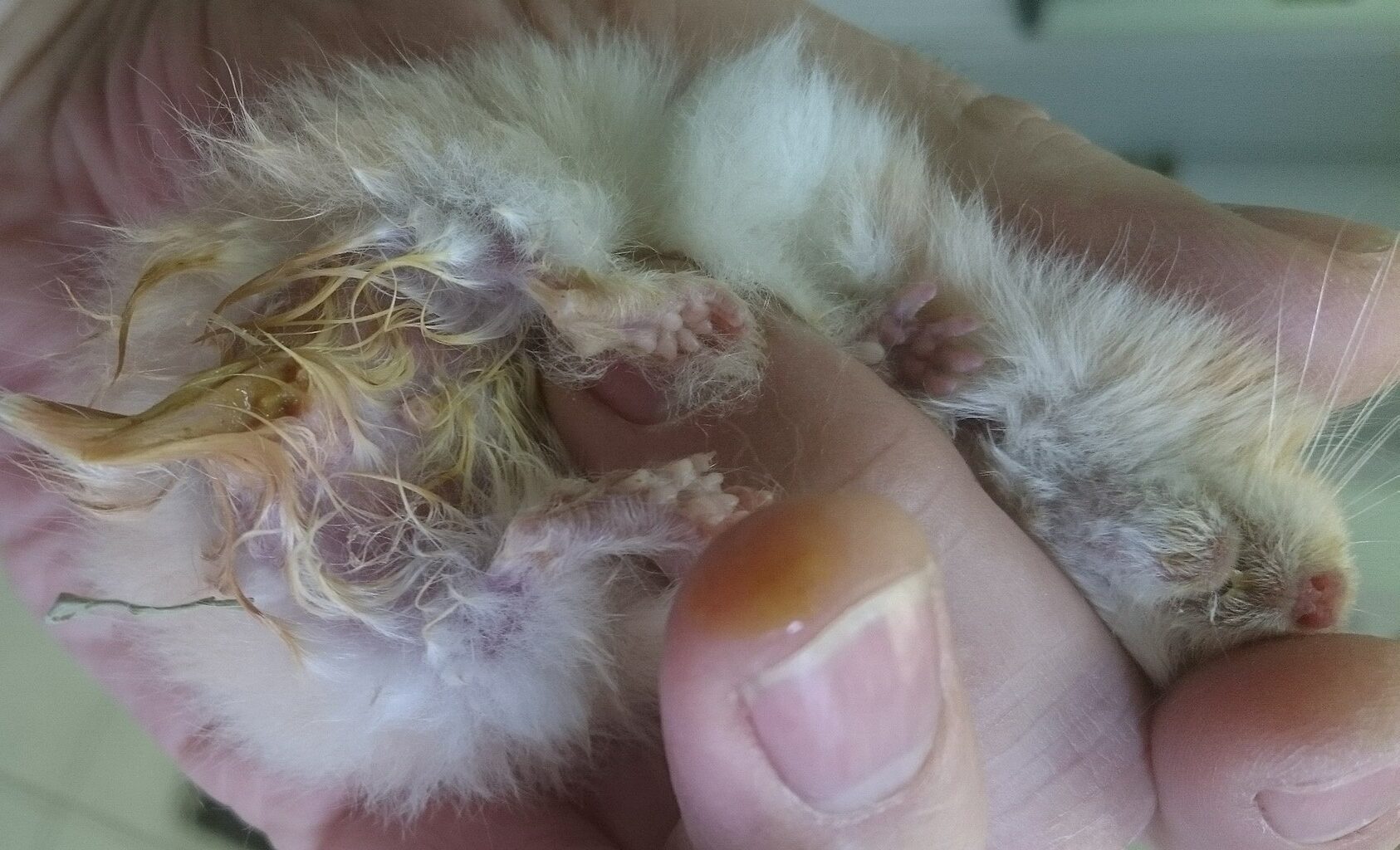Syringomyelia in a Cavalier King Charles Spaniel: Our Vet Explains

Updated on

Click to Skip Ahead
The Cavalier King Charles Spaniel is a beautiful and graceful dog with a warm and loving temperament. They’re generally a healthy breed but can be prone to certain diseases, such as syringomyelia and mitral valve disease.
Syringomyelia is a neurological disorder characterized by the formation of abnormal cavities in the spinal cord. The disease can appear in young dogs (about 3 months old), and its prevalence increases with age.
The causes of syringomyelia are represented by a skull malformation at the site where it joins the neck vertebrae, in which case the back part of the brain and the brainstem cannot develop normally because there isn’t enough room. In other words, the space inside dogs’ skulls is too small and the brain is too big.
In this article, you will learn what syringomyelia is, its causes and clinical signs, and how you can help your Cavalier King Charles Spaniel if they suffer from this neurological disorder.
What Is Syringomyelia?
Syringomyelia is the development of a fluid-filled cyst1 (syrinx) located in the spinal cord2. Over time, the cyst can grow in size as it fills with cerebrospinal fluid, compressing the nerve fibers that send information from the brain to the extremities. The cyst affects the spinal cord, causing pain, discomfort, and stiffness, among other clinical signs.
This condition occurs most often in Cavalier King Charles Spaniels but can also be encountered in other breeds, such as:
- Griffon Bruxellois (the breed with the second highest incidence)
- Bichon Maltese
- Chihuahua
- Yorkshire Terrier
- Pomeranian
- Boston Terrier
Syringomyelia can occur around the age of 3 months, but it is most frequently found in dogs between 3 months and 3–4 years old. The prevalence of this neurological disorder increases with age.
What Are the Signs of Syringomyelia?
The clinical signs of syringomyelia in Cavalier King Charles Spaniels are multiple and most commonly include neuropathic pain in the head, neck, and along the spine3. The pain manifests acutely and suddenly, and dogs will yelp and be reluctant to jump and climb.
- Phantom scratching (dogs make specific scratching movements with one of their hind limbs directed toward the head or neck, without the limb coming into contact with the skin)
- Hyperesthesia (increased intensity of sensations and perceptions)
- Allodynia (pain caused by a non-painful stimulus)
- Dysesthesia (spontaneous feeling of discomfort)
- Uncoordinated walk/wobbly walk
- Changes in behavior
- Cervical scoliosis
- Discomfort
- Paresis
The clinical signs that dogs with syringomyelia show are directly correlated with the location and size of the cyst. For example, a dog with a narrow and symmetrical cyst may not show any clinical signs, while a dog with a large and asymmetrical cyst may experience great pain and discomfort.
- Weather changes
- Stress
- Strong emotions
- Wearing a neck collar
What Are the Causes of Syringomyelia?
In the case of the Cavalier King Charles Spaniel, this neurological disorder is most likely genetically inherited.
- Chiari-like malformation is a developmental malformation of the skull and beginning of the neck vertebrae and is by far the most common cause of syringomyelia in dogs. This condition causes the cerebellum to herniate at the base of the skull and can lead to the accumulation of fluid in the spinal cord, causing syringomyelia.
- Syringomyelia can occur as a result of trauma, disease, hemorrhage, or cancer.
How Is Syringomyelia Diagnosed in Cavalier King Charles Spaniels?
Chiari-like malformation and syringomyelia can be suspected based on the clinical signs and the patient’s medical history. The best diagnostic method is magnetic resonance imaging (MRI); it can detect even the smallest changes in the affected dog’s nervous system.
MRI is a minimally invasive diagnostic method, which requires dogs to be sedated so they can remain still throughout the process. Otherwise, the images obtained will not be clear, and the veterinarian will not be able to make a diagnosis.
Computed tomography and radiography have many limitations regarding the diagnosis of syringomyelia in Cavalier King Charles Spaniels. As a result, the only method by which the presence of this neurological disorder can be confirmed is MRI. Also, the veterinarian will have to make a differential diagnosis with various other causes that can cause neuropathic pain, such as:
- Inflammation of the central nervous system (e.g., granulomatous meningoencephalomyelitis, steroid responsive meningoencephalitis)
- Diseases of the spine (e.g., intervertebral disc disease)
- Vertebral anomalies
- Cancer
If your dog rubs their face against the carpet often and scratches excessively, a differential diagnosis will be made with dermatological conditions.

What Are the Treatment Options for Syringomyelia in Cavalier King Charles Spaniels?
Treatment of syringomyelia in Cavalier King Charles Spaniels may include medical or surgical therapy.
Medical therapy includMedical therapy includes the administration of painkillers and anti-inflammatory drugs, such as Gabapentin or corticosteroids (e.g., prednisone). Gabapentin has few side effects, being safe and effective in dogs. In contrast, corticosteroids, though effective in managing signs of syringomyelia, can have severe side effects. For this reason, they are usually prescribed when dogs do not respond to other means of treatment. Other drugs, such as furosemide (diuretic) or omeprazole (antacid), can be prescribed to decrease the production of cerebrospinal fluid.
es the administration of anti-pain and anti-inflammatory drugs, such as Gabapentin or corticosteroids (e.g., prednisone). Gabapentin has few side effects, being safe and effective in dogs. In contrast, corticosteroids, though effective in treating syringomyelia, can have severe side effects. For this reason, they are usually prescribed when dogs do not respond to other means of treatment. Other drugs, such as furosemide (diuretic) or omeprazole (antacid), can be prescribed to decrease the production of cerebrospinal fluid.
Surgical therapy is taken into consideration when patients do not respond to medication. It can help reduce pain by decompressing the back of the skull in affected dogs, but the failure rate is high. More than half of the operated dogs will have a decline approximately 2 years after the procedure.
To ease dogs’ pain, acupuncture can be tried as adjuvant therapy.
How Do I Care for a Cavalier King Charles Spaniel With Syringomyelia?
If syringomyelia does not cause problems, monitoring your dog’s state of health may be sufficient, but if the clinical signs are problematic, regular visits to the vet’s office may be necessary. While there is no need to restrict or limit your dog’s activity, here’s what you can do for life improvements:
- Remove the collar from their neck.
- Buy raised food and water bowls for easier and pain-free feeding and drinking. The bowls should be at the height of your dog’s elbow.

Frequently Asked Questions (FAQs)
What Is the Life Expectancy of a Cavalier King Charles Spaniel With Syringomyelia?
Most dogs suffering from syringomyelia will lead an almost normal life, living up to 9 years (the average life expectancy of the Cavalier King Charles Spaniel is 10.7 years). Although most affected dogs will retain their ability to walk, some may have a wobbly walk or be tetraparetic. Sometimes dogs may have problems wearing neck collars, eating and drinking from low bowls, or being petted on the neck, but these difficulties will not shorten their lives, however, they may negatively impact their quality of life.
How Fast Does Syringomyelia Progress?
The progression of this condition is variable. Some dogs may only have mild pain, and neurological signs will develop slowly or not at all. Other dogs may experience severe neurological signs and intense pain within 12 months of the first clinical signs.
Conclusion
Syringomyelia is a neurological condition of Cavalier King Charles Spaniels in which fluid-filled cavities (cysts) develop in the upper part of the spinal cord, near the brain. These cysts affect the marrow as they enlarge and give the following clinical signs: pain, wobbly walking, behavioral changes, sudden yelping (due to acute pain), paresis, or phantom scratching. The treatment usually comprises painkillers and anti-inflammatory medication, and the life expectancy of the affected dogs is over 9 years.
Featured Image Credit: Nestor Rizhniak, Shutterstock













